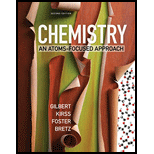
Chemistry: An Atoms-Focused Approach (Second Edition)
2nd Edition
ISBN: 9780393614053
Author: Thomas R. Gilbert, Rein V. Kirss, Stacey Lowery Bretz, Natalie Foster
Publisher: W. W. Norton & Company
expand_more
expand_more
format_list_bulleted
Question
Chapter 6, Problem 6.16VP
Interpretation Introduction
To find:
a) The intermolecular forces between the molecules in the representations
b) The substance that has the lowest boiling point among all nine representations.
c) Identify the representations that are isomers of each other.
d) The most soluble compound in water among ethylene glycol and iodine. Find the most soluble compound in carbon tetrachloride among ethylene glycol and iodine.
e) The hydrocarbon that has the higher boiling point.
f) The substance that does not form hydrogen bonds in between its molecules but can form hydrogen bonds to another molecule.
Expert Solution & Answer
Want to see the full answer?
Check out a sample textbook solution
Students have asked these similar questions
Two cations that exchange an electron in an interface, the exchange density is worth 1.39 mA/cm2 and the current density is worth 15 mA/cm2 at 25°C. If the overvoltage is 0.14 V, calculate the reaction rate and symmetry factor. Data: R = 8,314 J mol-1 k-1: F = 96500 C
With the help of the Tafel line, it is estimated that the interchange density of the VO2+/VO2+ system on the carbon paper has a value of 3 mA cm-2. Calculate a) the current density if the voltage has a value of 1.6 mV and the temperature is 25°C. b) the beta value of the anódico process if the Tafel pendulum is 0.6 V at 25°C. Data: R = 8.314 JK-1mol-1, y F = 96485 C mol-1.
Apply the NANSTE law to the MnO4- + 8H+ + 5e- ⇄ Mn2+ + 4H2O
Chapter 6 Solutions
Chemistry: An Atoms-Focused Approach (Second Edition)
Ch. 6 - Prob. 6.1VPCh. 6 - Prob. 6.2VPCh. 6 - Prob. 6.3VPCh. 6 - Prob. 6.4VPCh. 6 - Prob. 6.5VPCh. 6 - Prob. 6.6VPCh. 6 - Prob. 6.7VPCh. 6 - Prob. 6.8VPCh. 6 - Prob. 6.9VPCh. 6 - Prob. 6.10VP
Ch. 6 - Prob. 6.11VPCh. 6 - Prob. 6.12VPCh. 6 - Prob. 6.13VPCh. 6 - Prob. 6.14VPCh. 6 - Prob. 6.15VPCh. 6 - Prob. 6.16VPCh. 6 - Prob. 6.17QACh. 6 - Prob. 6.18QACh. 6 - Prob. 6.19QACh. 6 - Prob. 6.20QACh. 6 - Prob. 6.21QACh. 6 - Prob. 6.22QACh. 6 - Prob. 6.23QACh. 6 - Prob. 6.24QACh. 6 - Prob. 6.25QACh. 6 - Prob. 6.26QACh. 6 - Prob. 6.27QACh. 6 - Prob. 6.28QACh. 6 - Prob. 6.29QACh. 6 - Prob. 6.30QACh. 6 - Prob. 6.31QACh. 6 - Prob. 6.32QACh. 6 - Prob. 6.33QACh. 6 - Prob. 6.34QACh. 6 - Prob. 6.35QACh. 6 - Prob. 6.36QACh. 6 - Prob. 6.37QACh. 6 - Prob. 6.38QACh. 6 - Prob. 6.39QACh. 6 - Prob. 6.40QACh. 6 - Prob. 6.41QACh. 6 - Prob. 6.42QACh. 6 - Prob. 6.43QACh. 6 - Prob. 6.44QACh. 6 - Prob. 6.45QACh. 6 - Prob. 6.46QACh. 6 - Prob. 6.47QACh. 6 - Prob. 6.48QACh. 6 - Prob. 6.49QACh. 6 - Prob. 6.50QACh. 6 - Prob. 6.51QACh. 6 - Prob. 6.52QACh. 6 - Prob. 6.53QACh. 6 - Prob. 6.54QACh. 6 - Prob. 6.55QACh. 6 - Prob. 6.56QACh. 6 - Prob. 6.57QACh. 6 - Prob. 6.58QACh. 6 - Prob. 6.59QACh. 6 - Prob. 6.60QACh. 6 - Prob. 6.61QACh. 6 - Prob. 6.62QACh. 6 - Prob. 6.63QACh. 6 - Prob. 6.64QACh. 6 - Prob. 6.65QACh. 6 - Prob. 6.66QACh. 6 - Prob. 6.67QACh. 6 - Prob. 6.68QACh. 6 - Prob. 6.69QACh. 6 - Prob. 6.70QACh. 6 - Prob. 6.71QACh. 6 - Prob. 6.72QACh. 6 - Prob. 6.73QACh. 6 - Prob. 6.74QACh. 6 - Prob. 6.75QACh. 6 - Prob. 6.76QACh. 6 - Prob. 6.77QACh. 6 - Prob. 6.78QACh. 6 - Prob. 6.79QACh. 6 - Prob. 6.80QACh. 6 - Prob. 6.81QACh. 6 - Prob. 6.82QACh. 6 - Prob. 6.83QACh. 6 - Prob. 6.84QACh. 6 - Prob. 6.85QACh. 6 - Prob. 6.86QACh. 6 - Prob. 6.87QACh. 6 - Prob. 6.88QACh. 6 - Prob. 6.89QACh. 6 - Prob. 6.90QACh. 6 - Prob. 6.91QACh. 6 - Prob. 6.92QACh. 6 - Prob. 6.93QACh. 6 - Prob. 6.94QACh. 6 - Prob. 6.95QACh. 6 - Prob. 6.96QACh. 6 - Prob. 6.97QACh. 6 - Prob. 6.98QACh. 6 - Prob. 6.99QACh. 6 - Prob. 6.100QA
Knowledge Booster
Similar questions
- An electrode process takes place at a metal-solution interface. Indicate the current condition that must be met for Faradaic rectification to occur.arrow_forwardAt a metal-solution interface, an electron is exchanged, and the symmetry factor beta < 0.5 is found in the Butler-Volmer equation. What does this indicate?arrow_forwardTopic: Photochemistry and Photophysics of Supramoleculesarrow_forward
arrow_back_ios
SEE MORE QUESTIONS
arrow_forward_ios
Recommended textbooks for you
 ChemistryChemistryISBN:9781305957404Author:Steven S. Zumdahl, Susan A. Zumdahl, Donald J. DeCostePublisher:Cengage Learning
ChemistryChemistryISBN:9781305957404Author:Steven S. Zumdahl, Susan A. Zumdahl, Donald J. DeCostePublisher:Cengage Learning ChemistryChemistryISBN:9781259911156Author:Raymond Chang Dr., Jason Overby ProfessorPublisher:McGraw-Hill Education
ChemistryChemistryISBN:9781259911156Author:Raymond Chang Dr., Jason Overby ProfessorPublisher:McGraw-Hill Education Principles of Instrumental AnalysisChemistryISBN:9781305577213Author:Douglas A. Skoog, F. James Holler, Stanley R. CrouchPublisher:Cengage Learning
Principles of Instrumental AnalysisChemistryISBN:9781305577213Author:Douglas A. Skoog, F. James Holler, Stanley R. CrouchPublisher:Cengage Learning Organic ChemistryChemistryISBN:9780078021558Author:Janice Gorzynski Smith Dr.Publisher:McGraw-Hill Education
Organic ChemistryChemistryISBN:9780078021558Author:Janice Gorzynski Smith Dr.Publisher:McGraw-Hill Education Chemistry: Principles and ReactionsChemistryISBN:9781305079373Author:William L. Masterton, Cecile N. HurleyPublisher:Cengage Learning
Chemistry: Principles and ReactionsChemistryISBN:9781305079373Author:William L. Masterton, Cecile N. HurleyPublisher:Cengage Learning Elementary Principles of Chemical Processes, Bind...ChemistryISBN:9781118431221Author:Richard M. Felder, Ronald W. Rousseau, Lisa G. BullardPublisher:WILEY
Elementary Principles of Chemical Processes, Bind...ChemistryISBN:9781118431221Author:Richard M. Felder, Ronald W. Rousseau, Lisa G. BullardPublisher:WILEY

Chemistry
Chemistry
ISBN:9781305957404
Author:Steven S. Zumdahl, Susan A. Zumdahl, Donald J. DeCoste
Publisher:Cengage Learning

Chemistry
Chemistry
ISBN:9781259911156
Author:Raymond Chang Dr., Jason Overby Professor
Publisher:McGraw-Hill Education

Principles of Instrumental Analysis
Chemistry
ISBN:9781305577213
Author:Douglas A. Skoog, F. James Holler, Stanley R. Crouch
Publisher:Cengage Learning

Organic Chemistry
Chemistry
ISBN:9780078021558
Author:Janice Gorzynski Smith Dr.
Publisher:McGraw-Hill Education

Chemistry: Principles and Reactions
Chemistry
ISBN:9781305079373
Author:William L. Masterton, Cecile N. Hurley
Publisher:Cengage Learning

Elementary Principles of Chemical Processes, Bind...
Chemistry
ISBN:9781118431221
Author:Richard M. Felder, Ronald W. Rousseau, Lisa G. Bullard
Publisher:WILEY